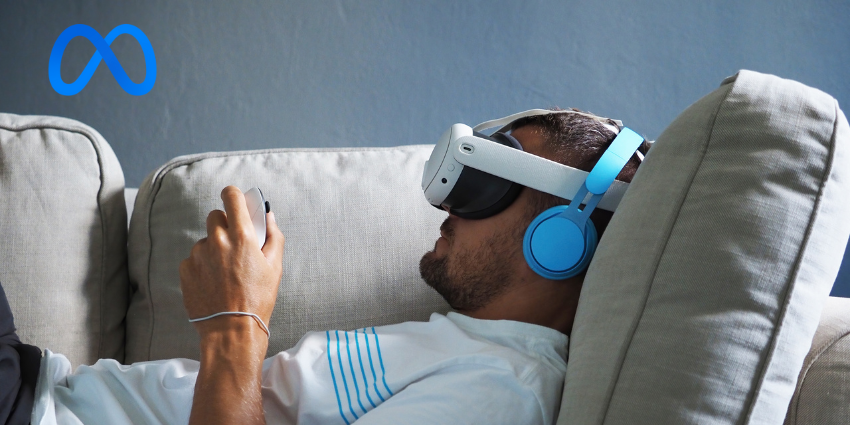Last month, during Connect 2024, Mark Zuckerberg, CEO and Founder of Meta revealed a prototype for the highly anticipated Orion device – a pair of AR smart glasses. At the event, Zuckerberg described the device as “the most advanced glasses in the world and our first prototype of full holographic AR.” He also introduced a significant breakthrough: neural interface interaction. Orion allows users to interact with the smart glasses using their brain’s electrical activity through a wrist device.
The new product comes as forecasts predict a significant increase in the popularity of AR smart glasses over the next five years. Groups such as ResearchAndMarkets recently published their “Smart Augmented Reality Glasses—Global Strategic Business Report,” which highlights the growth rates of smart glasses, potential opportunities for enterprises, and the possibility of smart glasses replacing VR headsets.
According to the report, the global market for smart glasses reached approximately 678,600 units in 2023 and is expected to grow significantly to 13 million units by 2030, representing a Compound Annual Growth Rate (CAGR) of 53.0 per cent from 2023 to 2030.
However, despite optimistic forecasts, the Orion device is not ready for the market—far from it. The version of Orion that will hit store shelves may look very different from the prototype device that Meta is currently showing off. However, Meta is repeating its “time machine” description of the Orion device, stating how the hardware is a glimpse into the emerging future of AR smart glasses.
Recently, Meta CTO Andrew Bosworth spoke on Adam Savage’s Tested show to explain some new details about the Orion prototype, its place in the Meta ecosystem, and current XR trends.
Developing Oiron: A Time Machine
Each Orion device costs Meta roughly $10,000 to produce, a far cry from affordable technology that can be mass-produced for consumers or enterprises. However, the key takeaway is innovation. Meta can create the technology, which is step one. Reducing the price of components and development to a point where Orion is affordable for large-scale audiences is next.
Bosworth noted that the idea of Orion being a market-ready product “was our goal,” meaning that despite currently lengthy R&D periods and high production costs, Meta still very much aims to eventually put the product in people’s hands in some form.
Luckily, Meta can trial AR smart glasses and features to a mass consumer market via its Meta Ray-Ban product, which is experiencing strong sales figures.
Bosworth added:
They [Orion] work, they’re spectacular. We are overjoyed with the devices. It ended up not being cost-effective as a product. So, it does stand as a time machine.
Orion: Specs and Features
Bosworth also explained that what’s “important” for Meta right now is creating an Orion prototype that is “fully working,” a goal the firm has seemingly achieved.
The CTO noted that the Orion device has an operating system and connects to the internet, meaning that the Meta and Reality Labs team has a device ready for developing dedicated system-shifting software while also opening “intuition around what software experiences will be great for what we believe is the type of device that will replace the phone someday.”
According to the CTO, Meta is working to integrate the product. Bosworth experienced various versions of Orion before Zuckerberg unveiled it at Connect 2024.
The CTO added:
It was very responsive, you’re looking at videos and you’re doing video calls, and it’s spectacular. It’s just spectacular. It’s a sense of real wonder. – It’s now gotten to this point where it’s a fully functioning system. You can walk around. It’s got 2-hour battery life. You can spend time in meetings. You’re able to have a really rich computer available to you without taking anything out of your pocket, without losing the context of where you are in the world, without breaking eye contact with someone that you’re talking to. It’s spectacular.
Moreover, speaking on Orion’s abilities, Bosworth explained that the AR device contains “a full colour, wide field of view display that’s responding to neural interfaces” powered by micro LED projectors. However, Bosworth noted that the Orion display technology is “not artefact-free, but it’s very close to artefact-free.”
The form factor and usability are vital and much-touted keys to the adoption of smart glasses. The Meta team does not lose sight of that factor. Bosworth explained that fitting technologies such as micro-LED displays, tracking, and neural interfaces into a device under 100 grams is crucial.
Bodworth added:
Getting all these new technologies and then trying to pack it into under 100 grams, that’s comfortable enough that you would be willing to wear it for its two-hour battery life and hopefully attractive enough that you feel like you could be taken seriously wearing these glasses. That’s important.
Project Oiron AI Integrations
AI is a crucial talking point in the XR space, which brought great investment into AR/VR/MR products this year and is, therefore, a natural fit for smart glasses products.
Bosworth added:
The thing that we didn’t anticipate five years ago, which has changed obviously in the last two years, is AI. – AI has come up, and we always thought it would be holograms first and AI would be later. We have the holograms. But AI is coming up fast and so I think a lot of the use cases that we’ll use with this actually will be querying the world around you – Just the ability to keep track of things by virtue of processing what’s going on as you go about the day.
Bosworth also noted that “unlike your phone,” AR smart glasses can fully leverage the context of a user’s surroundings to be “more helpful is that going to be as an assistant as you go about your life.” However, worries about AI smart glasses stealing data and threatening everyday privacy for consumers or businesses are already prevalent before mass adoption is anywhere near underway.
“AI feels like this bridge use case that makes even smaller displays feel more valuable, and then those can get richer and richer over time, adding more and more value,” remarked Bosworth.
Speaking on Ray Ban Meta AR Smart Glasses
Speaking on the development of Ray Ban Meta, the firm’s more basic market-ready AR devices, Bosworth noted that he was worried about “a big gap between things like the Ray-Ban Metas and the Orion. ” However, he notes there is a “spectrum” within the Meta portfolio, allowing for the range of AR devices to coexist going forward.
Bosworth continued:
They have a lot of relationships. So, certainly, when you’re doing slam VIO, when you’re doing some of the work on core processors or custom silicon on wireless, that work is shared between the two teams. That’s wonderful. There’s a big base of shared work, but there’s also a lot of work that is very different.
Furthermore, speaking on the broader Meta device ecosystem, which includes MR headsets, the CTO said the use cases for AR smart glasses and MR headsets are very different, “even though they do things that look very similar.”
“You can use similar words to describe them in practice; they’re very different; I kind of liken it to the difference between my phone and my laptop,” Bosworth explained.
“They do some similar things, and that’s great,” Bosworth said. He added that transferring shared use cases is valuable to a consumer while also explaining AR/VR/MR devices “do some very different things.”
Bosworth explained, “The ability to be completely immersed in a VR headset is a tremendously valuable asset. It can be done no other way; you should build a device that’s really, really good at that rather than trying to force everything into a convergence.”







